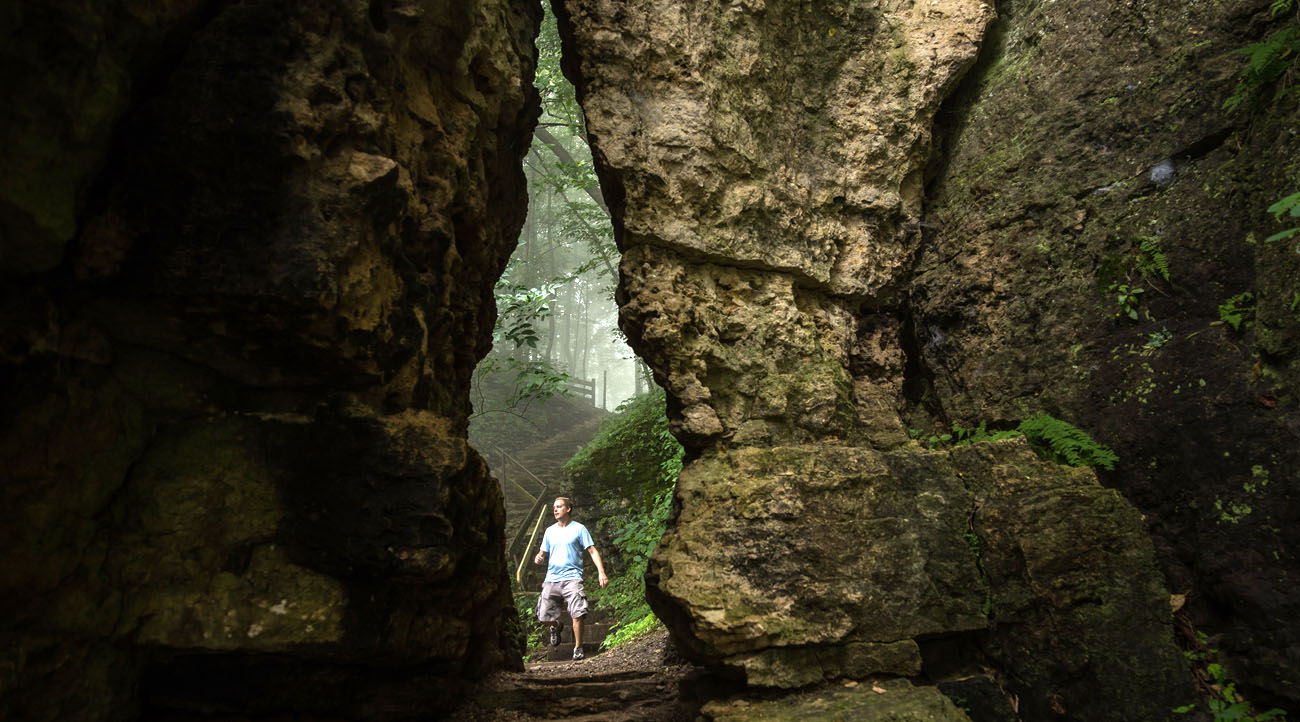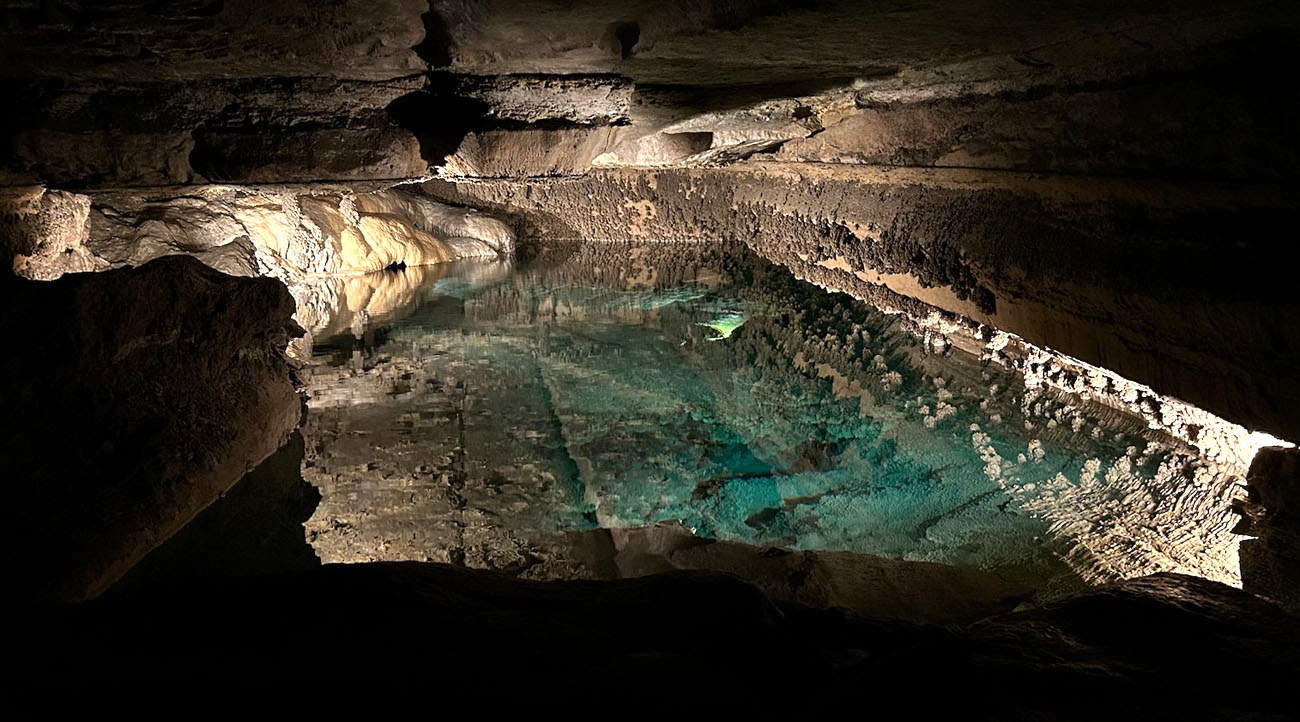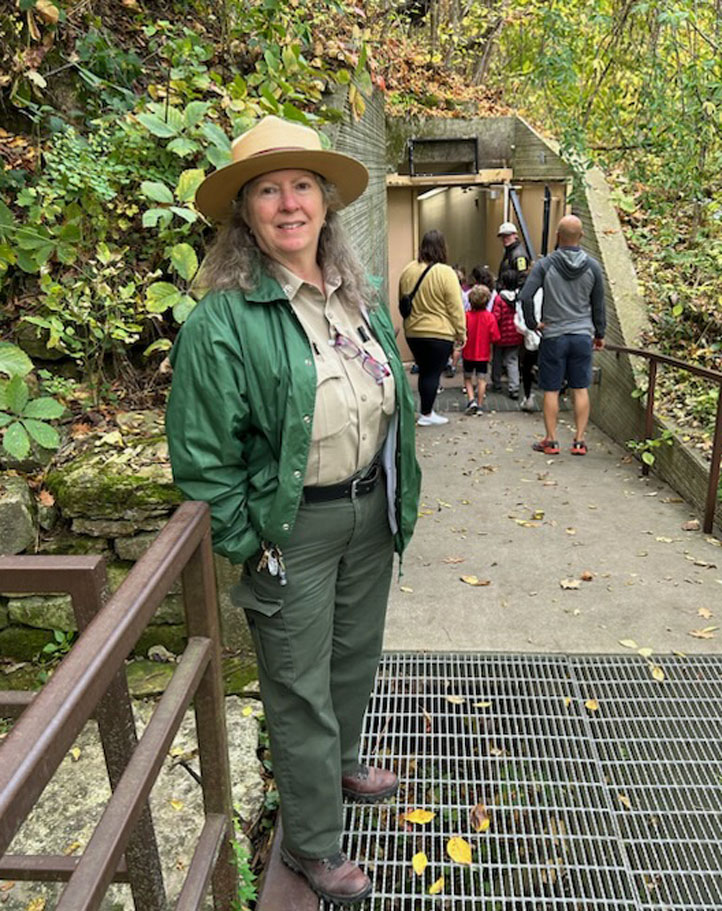
A family explores Cave of the Mounds, located in Dane County Wisconsin (link in article below). Cave of the Mounds takes its name from the Blue Mounds, two large hill landmarks. The main cavern began forming over a million years ago as water dissolved the limestone bedrock below the surface. (Photo courtesy of DARK Trail)
Explore the Driftless Area via the DARK Trail
FILLMORE COUNTY — The South Branch of the Root River begins in western Fillmore County and meanders slowly eastward, eventually meeting up with the North Branch near Lanesboro before exiting into the Mississippi River east of Hokah. Unbeknownst to many, just outside of Mystery Cave north of Cherry Grove, the river disappears under a bridge on Old Cave Road – then mysteriously reappears two-miles downstream.
This Disappearing River, as it is called, is a visual metaphor for how karst geology works in the Upper Midwest’s Driftless Area – a kind of “now you see it, now you don’t” magical slight of hand. Karst geology is a familiar feature of southeast Minnesota. Over time, moving water has eroded the fragile limestone sub-surface carving out caves, trout streams and sinkholes.
The Driftless Area, also known as the Paleozoic Plateau, is a four-state, 24,000 square mile area in the Midwest that was missed by the melting glacial drift from the last Ice Age. That’s why the area is called Driftless.
Dawn Ryan, the manager of Mystery Cave, is one of the movers behind an effort to educate the public about the unique features of the Driftless area through an initiative called the Driftless ARea Karst Trail – DARK Trail for short.
DARK Trail is an online website with links to drivable destinations in Minnesota, Iowa, Wisconsin, and Illinois. Each state is broken up into featured counties. All in all, there are 69 sites that the public can visit. Minnesota identifies sites in Fillmore, Goodhue, Houston, Mower and Winona counties.
In addition to the website, a Flyover Country App, created by the University of Minnesota and the National Science Foundation, is a handy go-to application for mobile phones.

Wyalusing State Park is located south of Prairie du Chien, Wisconsin near the confluence of the Wisconsin and Mississippi Rivers. The 500-foot river bluffs have changed little since indigenous tribes walked these lands. The park features rock formations, trails and caves. (Photo courtesy of DARK Trail)
Discovery Areas
Discovery areas include caves, springs, sinkholes, streams, state parks, special nature areas, scenic overlooks and exhibits. And even getting there, driving along the many scenic byways, features dramatic vistas like the Great River Road along the Mississippi River.
In Wisconsin, there is Cave of the Mounds (pictured at top) near Madison and Crystal Cave in Pierce County, the longest cave in the state, with 4,600 feet of passages featuring iron ore, flint and quartz crystals; exhibits educate the public about geological periods, as well the fossils and bats in the cave.
Near Apple River, Illinois (northeast of Galena), visitors can hike trails in Apple River Canyon State Park that feature limestone bluffs, deep ravines, springs and streams. The Apple River has cut through dolomite, limestone and shale deposits carving the canyon and massive cliffs.
In nearby northeast Iowa you can stop by the Marquette Scenic Overlook and Mississippi River Boardwalk. Tucked into a limestone bluff above the community of Marquette, the overlook provides an expansive view of the Upper Mississippi River Valley.
And closer to home, Fillmore and Houston counties give the visitor countless sites to discover the Driftless. From Forestville/Mystery Cave State Park and Niagara Cave in Fillmore County to Big Spring – Beaver Creek Valley State Park and the Dresbach Welcome Center in Houston County.

Turquoise Lake is a popular feature at Mystery Cave in Fillmore County. The 13-mile long cave was discovered in 1937 and purchased by the state of Minnesota in 1988. Guided tours are offered daily in the summer. (Photo by John Torgrimson)
Canary in the Coal Mine
Dawn Ryan’s introduction to Mystery Cave was in 2008 when she helped survey invertebrates and other animals living in the cave. She was working at the time at Sequoia and King’s Canyon National Parks in California.
“Invertebrates are the canary in the coal mine, when it comes to water quality,” Ryan told me on a tour of Mystery Cave. “The cave is susceptible to flooding and surface runoff from activity above ground which threatens living things underground.” She is very concerned about the long-term threats of climate change.
The survey work piqued her interest in the 13-mile cave system and in 2019 she moved from California to become Mystery Cave’s manager. That same year, Ryan attended the National Cave and Karst Management Symposium. It was here that she learned about the state of Virginia’s Cave and Karst Trail, with more than a dozen stops where visitors can learn about caves and karst features.
To celebrate the International Year of Caves and Karst in 2021/2022, Ryan set out to organize the DARK Trail, which is modeled on the Virginia trail.
“At first it was like herding cats,” Ryan joked about the outreach to other organizations. “But eventually everyone got on board.”

Dawn Ryan, manager of Mystery Cave, helped create the DARK Trail website and App after learning about a similar cave and karst trail in Virginia. In the background, students enter into the cave for a guided tour by Mystery Cave staff. (Photo by John Torgrimson)
DARK Trail was developed in cooperation with the National Speleological Society and included partner organizations in four states and around the country.
The organizing group received a grant from the Southeast Minnesota Regional Sustainable Development Program at the University of Minnesota, to hire a PhD student to develop a Marketing and Outreach plan. This included branding, developing a social media presence on Instagram, Facebook and YouTube, and producing a 6-minute DARK video introducing the Driftless Area Karst Trail website and Flyover Country App launch.
The goal of the DARK Trail is to use modern tools, such as the website and mobile app, to provide access to information that will encourage visitors to explore the many wonders of the Driftless Area.
As elementary students gathered for a tour of Mystery Cave on a sunny fall morning, excitement rising in their voices, Ryan said, “This is what it’s all about. Educating kids and the public about the unique geological features of the Driftless Area and our relationship with nature.”
…………………

Contributor
John Torgrimson is the editor and co-publisher of Root River Current.





